2024
Western States Rural Transportation Technology Implementers Forum
June 18th-20th, Yreka, California

2024 Image Gallery coming soon!
SCHEDULE OF EVENTS
Tuesday, June 18, 2024
4:00 pm to 7:00 pm Registration
5:00 pm to 6:30 pm Reception (no-host)
6:30 pm to 9:00 pm Dinner
Wednesday, June 19, 2024
7:00 am to 8:00 am Breakfast
8:00 am to 11:40 am Welcome and Technical Presentations
11:40 am to 12:45 pm Lunch
12:45 pm to 5:20 pm Technical Presentations, Evaluations, Remarks
6:00 pm to 11:00 pm Dinner and Networking Session
Thursday, June 20, 2024
7:00 am to 8:00 am Breakfast
8:00 am to 12:10 pm Technical Presentations
12:10 pm to 12:30 pm Speaker and Attendee Recognition
12:10 pm to 12:30 pm Concluding Remarks and Evaluations
12:30 pm to End Lunch
PRESENTATIONS AND DEMONSTRATIONS*
Utilizing Fuel Cell Technology to Power Transportation Management System Elements During Public Safety Power Shutoff Events
Jeremiah Pearce, Caltrans District 2
Dave Torick, AHMCT UC Davis
Justin Ellis, Caltrans EQASI
Hydrogen Fuel Cell Backup Power Systems for ITS Applications in District 2: Need and Purpose (Pearce) (pdf)
Hydrogen Fuel Cell Backup Power Systems (HFC) for ITS Elements - Part 2, Research Project (Torick) (pdf)
HFCS Testing at the TransLab (Ellis) (pdf)
Next Steps (Pearce) (pdf)
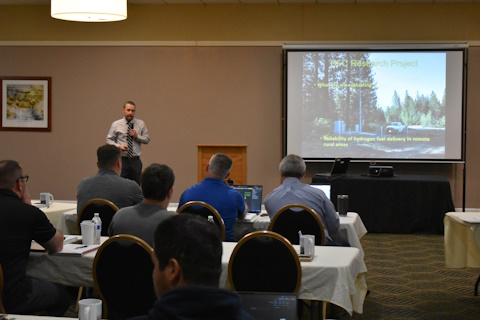
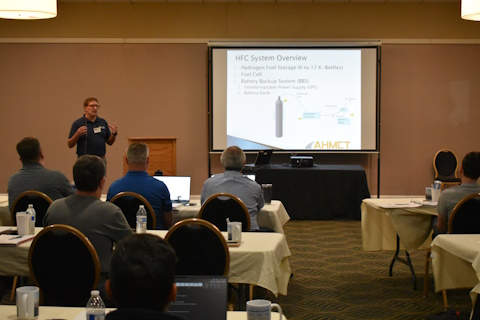
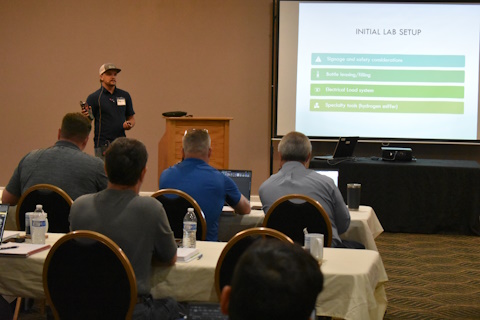
|
California and other western states continue to face increased wildfire risk and associated impacts. In some cases, utilities must turn off power during severe weather in an effort to prevent wildfires. This is called a Public Safety Power Shutoff (PSPS). A PSPS has a large safety and operational impact to Caltrans, including outages to traffic signal equipped intersections, Intelligent Transportation Systems (ITS) and communication hubs. Caltrans has considered the use of solar and battery storage and small portable generators to help mitigate the effects of PSPSs on the transportation network, but these options are resource intensive, unavailable, and/or impractical in terms of footprint, maintenance, and cost. Alternatively, hydrogen fuel cell technology shows potential for a possible solution. Jeremiah Pearce, Caltrans District 2, Dave Torick, AHMCT at UC Davis, and Justin Ellis from Caltrans EQASI, reviewed the research pilot project initiated to evaluate the use of hydrogen fuel cell technology at PSPS impacted field sites. This project was scoped to evaluate the procurement, construction, installation, integration, operation, maintenance and refueling processes of these systems at four sites in the most PSPS impacted rural regions of California. The team discussed the project’s successes, failures, and lessons learned.
|
Jeremiah Pearce

Photo by Doug Galarus
Dave Torick

Photo by Doug Galarus
Justin Ellis

Photo by Doug Galarus
Let There Be Light: Tunnel Lighting Controls (pdf)
Frederick Tydeman, Eric MacGill, Kevin Maxwell
Nevada Department of Transportation
Note: A version with the embedded video clips is available here. The file is ~699 MB in size. To view the videos, you may want to download and access the file locally and be sure to use more recent versions of Adobe Reader.
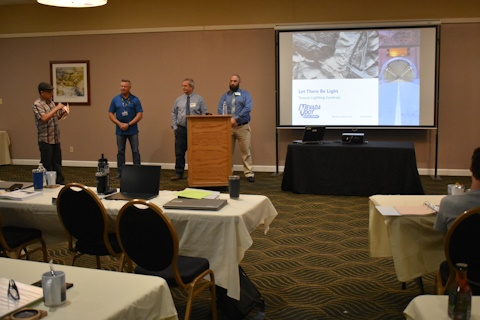
|
Frederick Tydeman, Eric MacGill, and Kevin Maxwell from the Nevada Department of Transportation teamed up to present the new luminaire control system they have deployed in the Carlin Tunnel in northern Nevada. The Tunnel Lighting Addressable Control System – Energy Management eliminates the need for control conductors or antenna installation by using power line carrier control technology. A luminance photometer measures the luminance at the tunnel entrance and the data is transmitted to a lighting control cabinet (LCC). Via power line carrier communications, the LCC dynamically adjusts the tunnel’s lighting at each luminaire based on real-time external ambient lighting conditions. The team first discussed the background of the project including the existing lighting system. They then discussed the design of the new system including details for the layout, remote access and network integration with the Elko TMC, and the various system components.
|
On left, Andres Chavez introduces left to right Kevin Maxwell, Eric MacGill, and Frederick Tydeman.

Photo by Doug Galarus
Evaluation of Starlink Satellite Broadband Communications for Caltrans ITS Field Elements (pdf)
Saeid Delshad
Advanced Highway Maintenance and Construction Technology (AHMCT) Research Center, University of California Davis
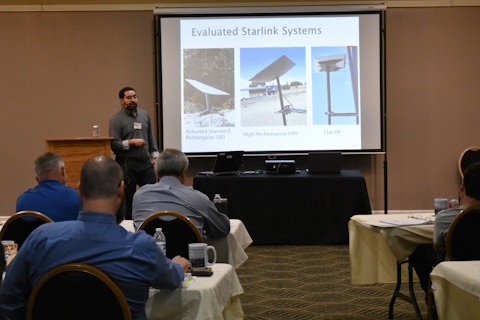
|
Establishing reliable high-bandwidth communications is critical to the operation of ITS field elements including digital message signs, warning systems, CCTV sites, and RWIS – systems deployed to enhance safety and mitigate the impacts of wildfires, snowstorms, floods, landslides, and other incidents. While California is deploying fiber-optic broadband services in the state, completion is several years out and will only be deployed along select rural highways. To address this challenge, the Advanced Highway Maintenance and Construction Technology (AHMCT) Research Center at UC Davis is evaluating the use of SpaceX Starlink satellite broadband communication services for Caltrans District 2 (Redding Fiber Hub, four CCTV sites). Dr. Saeid Delshad reviewed the documented technical information for the systems, latest technology advancements, and current limitations to integrating Starlink systems into existing Caltrans ITS field networks. He reviewed procurement, installation, integration, and maintenance of the systems as well as results of field testing supported by Caltrans District 2 ITS engineers.
|
Saeid Delshad

Photo by Doug Galarus
Washington’s Virtual Coordination Center (VCC) (pdf)
Brent Quebedeaux, David Baker
Washington State Department of Transportation
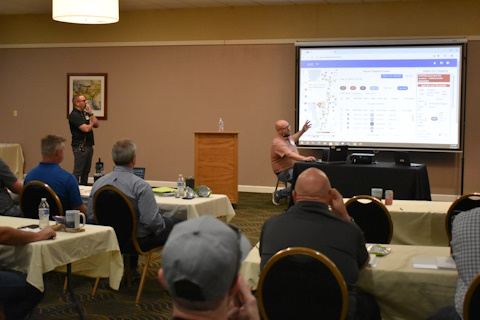
|
Washington’s Virtual Coordination Center (VCC) is a “web-based incident management tool that allows for the sharing of accurate real time data and coordination between partner agencies.” Created with Seattle area public and private partners in response to several large-scale incidents, the VCC facilitates more efficient communications between multiple agency partners for real time situational awareness and response. WSDOT’s IT Project Manager Brent Quebedeaux and Incident Management Coordinator David Baker provided background on the project including why it was created and partners who were involved. They reviewed the project design and architecture, various tools used, and funding mechanisms used to bring the project to fruition. Brent and David demonstrated the VCC to the audience for a practical look at the features and operations and then discussed lessons learned along with plans and considerations for future expansion statewide, including availability in more rural areas.
|
Brent Quebedeaux (left) and David Baker (right)

Photo by Doug Galarus
OSS by the Numbers - Analytics and their use on the One-Stop-Shop for Rural Traveler Information (pdf)
Douglas Galarus
Montana Technological University
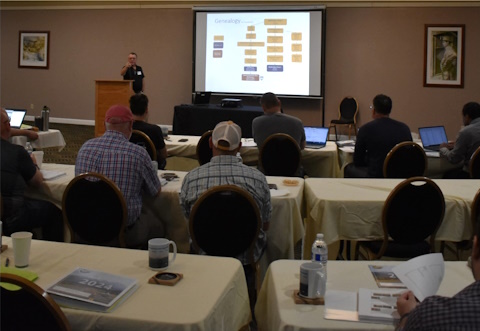
|
The One-Stop-Shop (OSS) for Rural Traveler Information is the result of a multi-phased research and development effort by Caltrans and the Western States Rural Transportation Consortium (WSRTC). Different aspects of the One-Stop-Shop’s development have been presented at past Forums. This year, participants learned how collection and analysis of usage data affects operation and maintenance of OSS and how well it meets the goals the system was designed to address. Dr. Doug Galarus from Montana Tech provided some background on the OSS project overall and explained some basics of analytics. He showed usage statistics both in terms of historical usage and geographical usage, and then broke it down to further characterize user sessions. Doug discussed recent changes for collecting analytics and next steps for maintenance of the system.
|
Douglas Galarus

Photo by Caltrans District 2
Streamlining ITS: Unifying Variable Speed Limits and Lane Control Across State Agencies (pdf)
Ansley Skillern
Southwest Research Institute
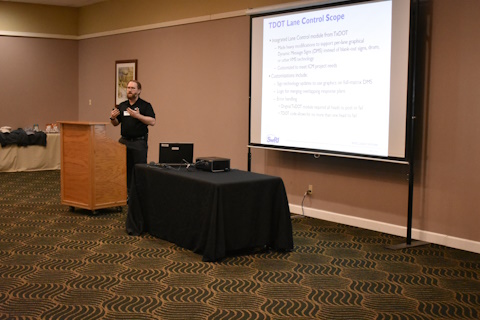
|
Ansley Skillern from the Southwest Research Institute (SWRI) discussed their efforts with state DOTs related to developing and implementing Variable Speed Limit (VSL) and Lane Control Sign (LCS) applications. He first explained some background on the various systems and ActiveITS project work with the three DOTs that were the focus of the presentation. Ansley discussed the different regulatory considerations, business rules, and strategies for implementing VSL and LCS systems. He reviewed some of the technical challenges to integrating such systems with distinct business logic into a state-owned advanced traffic management system such as ActiveITS. Ansley shared lessons learned and discussed next steps for future agency integration.
|
Ansley Skillern

Photo by Douglas Galarus
Wrong-Way Driving (WWD) Detection Systems Update (pdf)
Kent Thurston, Adam Lough, P.E.
Utah Department of Transportation
Note: A version with the embedded video clips is available here. The file is ~481 MB in size. To view the videos, you may want to download and access the file locally and be sure to use more recent versions of Adobe Reader.
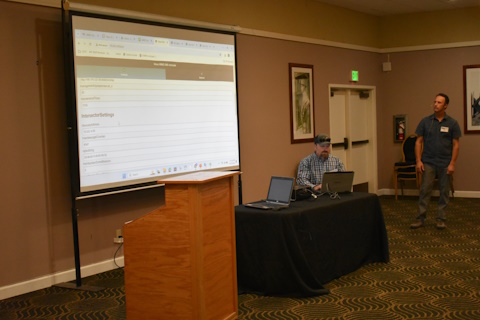
|
In a follow-up to a 2021 presentation on an original system, a team of speakers from Utah DOT provided an update on their wrong-way driving detection systems including demonstrations of how the systems operate. Kent Thurston and Adam Lough first provided some history and background on the first project that was presented in 2021, including lessons learned and how the project directed selection of the new, preferred system. The team reviewed how they tested, compared, and ultimately chose the new system for deployment. They shared details on the 23 systems deployed statewide, how the locations were prioritized, and technical details for installation. Kent and Adam also included some early alert outcomes from the new system and discussed the anticipated safety benefits.
|
Kent Thurston (seated) and Adam Lough (standing)

Photo by Douglas Galarus
TOP











